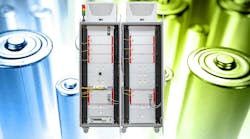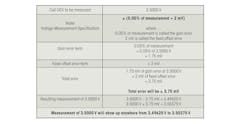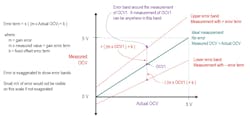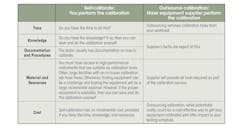Members can download this article in PDF format.
What you'll learn:
- The importance of calibration for all electronic test equipment.
- The main reason why such equipment must be regularly calibrated.
- The pros and cons of self-calibration or using outside services.
It’s a fact of life that all electronic test equipment must be calibrated. Typically done annually, calibration is necessary to ensure that the equipment continues to provide the performance specifications that you require—and the performance you paid for when making your equipment investment. As time progresses, the equipment will slowly drift out of specification. Calibration returns the equipment to operation within the specification.
Once the calibration period expires, you can’t rely on the battery tester to provide the performance you need as its performance isn’t specified past the calibration interval. Typically, the calibration interval is one year. When you don’t perform calibration, this drift will mean that voltage sources will no longer source the voltage to the required accuracy, giving you the wrong voltage output. Likewise, this drift will cause measurements to have additional error such that you can’t trust the readings.
Many times over the years, I’ve heard people say: “I paid a lot of money for this equipment; I expect it to be in specification for the life of the equipment.” Of course, this is nonsense. In fact, the best equipment is the most critical to keep calibrated, because you paid a lot of money for your equipment to get the best performance.
Letting the calibration lapse undermines your investment and results in operation with poor performance, perhaps even worse than the performance of equipment of a far lower price and quality. If careful control of a source and accurate measurement is needed, then the battery tester must be calibrated according to the manufacturer’s recommendations.
Calibration can be done mechanically, by turning potentiometers or making similar manual adjustments inside of the equipment. More likely, though, the equipment is calibrated electronically. With electronic calibration, there’s no need to open the tester’s cabinet to make adjustments. For more information on the process of electronic calibration and how it actually works, check out the article “Demystifying Electronic Calibration.”
Why is Calibration Necessary?
Electronics drift due to time and the stresses of operation. While the test equipment was in perfect calibration when it left the factory, components inside will drift over time due to many factors, including mechanical shock (like dropping the instrument or roughly moving the system) or heat cycling (as the equipment heats up and cools down during normal operation). The purpose of performing calibration at set intervals is to ensure the battery tester is returned to its best calibrated state before it drifts out of specification.
Let’s look at a voltage measurement as an example of why calibration is necessary. In this example, we want to measure the open circuit voltage (OCV) of a lithium-ion cell. The cell has an OCV of 3.5000 V. This is the true OCV. Now we want to measure the OCV using the battery tester. Table 1 shows how to determine the measurement error.
The figure shows how this measurement specification compares to the true or actual OCV.
Without calibration, it’s possible that an out-of-calibration measurement could be worse, perhaps
± (0.07% of measurement + 8 mV). In this case, the error on the true 3.5000 V OCV jumps up from
±3.75 mV when in calibration to ±10.45 mV when out of calibration, resulting in a measurement that could be anywhere in the range of 3.48955 to 3.51045 V.
To further this example, if you were relying on this voltage measurement of OCV to terminate a charge step when measuring capacity, the capacity determination would be wrong because you stopped the charge step either too soon or too late, due to the wide error in the OCV measurement. The voltage error propagates into other measurements.
Clearly, when you depend on your battery test equipment to deliver reliable and accurate results, you need to minimize errors by keeping the equipment calibrated.
How to Calibrate: Self-Calibration or Outside Services?
Oftentimes, battery test equipment can be calibrated by you, the user. Equipment service manuals include a list of required instruments that were selected to have sufficient capability to provide a calibration that will restore the battery tester to its factory specifications. Typically, these instruments will need to be 4X to 10X more accurate than the battery tester.
The manual also has precise, step-by-step instructions to perform the calibration. Sometimes, calibration software is provided to remove human error from the tedious tasks associated with calibrating large channel count testers.
However, you will need access to the right instruments to perform the calibration. Such calibration instruments can be expensive because they must provide superior performance. Lastly, you will need technicians who are capable and available to properly perform the calibration. Self-calibration, because you’re doing the work with your resources, will likely be less expensive than having a manufacturer’s service technician perform this calibration operation.
Alternatively, battery test equipment manufacturers also offer calibration services. For large testers, the calibration service will be performed in your test lab, as it may not be feasible to move the testers. On-site calibration services can be pricey, so for benchtop battery testers, it may be more cost-effective to return the equipment to a qualified service center.
Ultimately, deciding between self-calibration and calibration by the manufacturer is similar to deciding if you want to fix your own car. Do you have the time, skills, and resources needed? If so, fixing your car is more cost-effective than having a mechanic fix the car. But if you don’t know how to make the repair, or need to buy a set of expensive tools, or simply don’t have the time, then maybe it’s better to let the mechanic do it. Table 2 compares these two alternatives for calibrating a tester.
Follow a Calibration Schedule
Your battery tester contains a charger (source), discharger (load), voltmeter to measure battery voltage, and an ammeter to measure battery current. For your battery tester, power source control must be carefully maintained, for example, to ensure a charger doesn’t overcharge a battery. Likewise, your battery tester is used where accurate measurement is needed, such as to report on the measured capacity of a battery.
Following the calibration schedule for your testers, you can ensure your equipment gives the desired peak performance, while failure to calibrate means you can’t trust the results.



